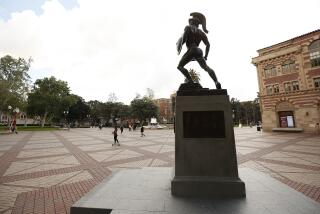New UCI Research Center Will Link Arts, Business
- Share via
IRVINE — Touted as good news for business and good news for the arts, a $1.5-million high-tech multimedia learning and research center is expected to break ground at UC Irvine in March 1999.
Funded by Rockwell International Corp., the Donald R. and Joan F. Beall Gallery and Center for Multimedia, named in honor of the firm’s outgoing chief executive and his wife, will occupy a portion of the campus art gallery.
David Trend, chairman of the studio art department at UCI, said the digital-arts center fills a need in Southern California, where the economy is resurging but the multimedia entertainment and computer industries are stymied by a “lack of qualified applicants, specifically, people trained in the arts.”
“They need people who know how to tell stories, who know how to draw and perform for the camera--and also students who know how to learn.”
Job candidates with a liberal-arts education are especially attractive to high-tech businesses, Trend said, because that discipline “teaches people how to be critically engaged learners.” “Digital arts” is the phrase du jour for a whole universe of electronically produced objects and experiences, including CD-ROMs, video games, theme-park simulations, electronic music, Web pages and animation.
*
Conceived by Jill Beck, dean of the School of the Arts, to honor Donald Beall’s interests in business, engineering and the arts, the center will be allied with UCI’s 6-month-old digital-arts minor, which has quickly attracted students majoring in both arts and sciences.
The art gallery--which will be enlarged in the front and rear--will contain a multimedia experimentation and gallery area with computer work stations where visitors can view students’ CD-ROMs and see large-scale projections of computer images.
Trend said the center, the first of its kind in the UC system, involves four levels of cross-fertilization.
Students working in different art forms will come together to work on a multimedia project (for example, a visual artist, a composer and a dancer collaborating on a CD-ROM). Student artists will also develop projects with students in computer science, engineering and other non-arts disciplines.
A third level of collaboration will occur between the campus and technology businesses looking for creative ways to test their products. And too, the gallery will showcase public school projects produced under the auspices of UCI’s Digital ArtsBridge community outreach program, launched last fall.
*
A “cyber” cafe in front of the gallery will be modeled after the popular computer-appointed Net-and-Java joints that have sprung up globally. Trend said the idea is to make the gallery “a more friendly, accessible” space.
Though the Rockwell donation will pay for bricks and mortar, Trend said the School of the Arts will seek more money (the precise goal has not yet been established) for the center’s hardware and software. An architect will be selected by late March.
Pending the results of a bond issue, the campus could also begin construction in 1999 on a three-story studio art building including at least one or two more galleries.
This sudden burst of construction (another arts building is also due to be refurbished) is part of a broad new outlook, Trend said, exemplified by the pedestrian bridge that opened last fall between the School of the Arts and the rest of the campus. “It’s practical but also symbolic: We’re no longer this isolated entity.”
More to Read
The biggest entertainment stories
Get our big stories about Hollywood, film, television, music, arts, culture and more right in your inbox as soon as they publish.
You may occasionally receive promotional content from the Los Angeles Times.










